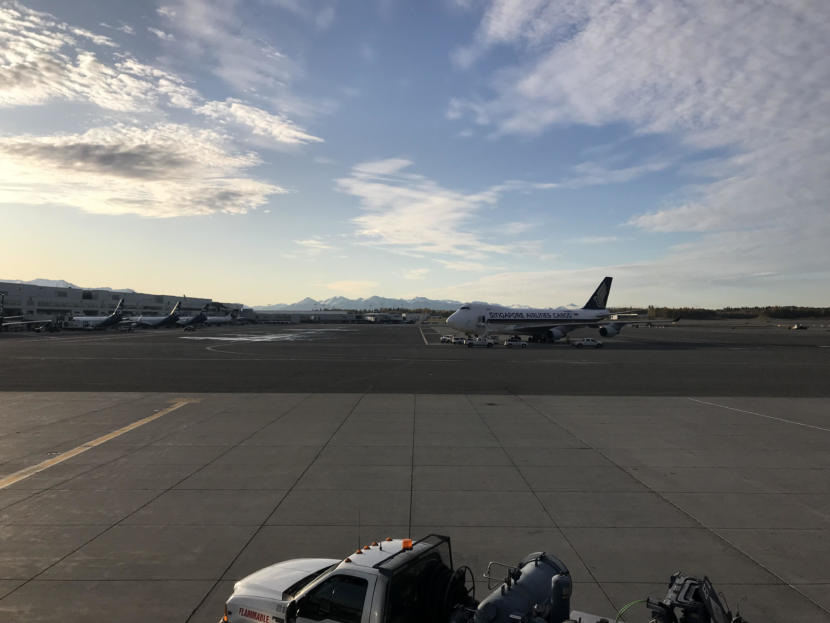
The Ted Stevens Anchorage International Airport was once a hub of global travel. Passenger planes from around the world would frequently touch down in the city. Today, the halls of the international terminal are much quieter, but airport leaders are hoping to draw more global traffic back to the state.
The North Terminal of the airport in Alaska’s largest city looks and sounds a lot like any other. But there aren’t many travelers.
The state’s Department of Transportation and Public Facilities is hoping to change that. The department is looking for private companies who want to partner with the state to essentially take things over at the terminal.
Airport Manager Jim Szczesniak said the last time the terminal had a makeover was 1993.
“As we look to increase our international traffic, we’re going to need to upgrade that facility to a more modern international standard that all passengers expect,” Szczesniak said. “So we’re trying to get the private sector to come in and evaluate if there’s ways that they can work with us to help make that happen.”
It’s unclear right now exactly what this partnership would look like. The state is still waiting to hear if any private companies are even interested. But the idea is that the partner could bring the interior design up to date, operate stores and restaurants and share revenue.
Szczesniak said the partnership is part of a goal to grow the number of international flights landing in Anchorage.
“They would have the ability to say, ‘Yes, if you bring your flights to this facility, we will make it nice,’ like they have the reputation to do at their other facilities,” Szczesniak said.
What would increased international travel to Anchorage look like?
Leaders in China and Alaska have been working toward developing a nonstop flight to and from Anchorage.
A few factors have delayed the China flight — including ongoing trade tensions with the U.S., and a shortage of airplanes after Boeing 737 Max models were grounded earlier this year.
Leaders are also exploring a stopover model. In a recent tour of the airport’s cargo operations, Alaska Gov. Mike Dunleavy suggested potential for the state to follow Iceland’s lead.
Icelandair offers passengers flying across the Atlantic Ocean the chance to stop in the country for up to seven days before continuing to their destination. The stop doesn’t add any cost to the flight.

“If we can have some of these foreign visitors stay a certain amount of time in Anchorage and possibly in Fairbanks, I think we’re going to see a boon in that aspect of tourism too,” Dunleavy said. “And not just in the summertime but in the wintertime. We’re working all angles of what Alaska has to offer the world.”
There is precedent for a strong global presence at the North International Terminal. In large part, the story of how it diminished has to do with the evolution of airplanes. Samuel Engel is an aviation expert with ICF, a consulting group.
“Anchorage was a critical stopping point for the trans-Pacific routes between North America and Asia because it was difficult for the aircraft to make the entire trip without a stop somewhere,” Engel said. “And Anchorage was a very good place to stop on the route.”
Engel, senior vice president at ICF, said when the technology got more advanced and planes could fly further without stopping, Anchorage lost that place in the skies. Revitalizing the airport’s international terminal could be a tough sell, Engel said.
“For passenger service, Anchorage is no longer as critical for the airlines for a fueling stop,” Engel said. “And it needs to be evaluated on the actual demand for traffic to and from Anchorage.”
Engel said that’s the tough part. Airlines need to fill planes, and economically, Anchorage is not the most efficient place to do that. But, there is one area that Engel sees potential for the airport. And this time, the advancement of airplane technology could be a good thing for Anchorage.
Smaller planes are now able to fly further distances. That means airlines can fly economically with less people.
“That ability to fly long distances with a smaller plane means potentially that smaller cities will see new kinds of long distance service,” Engel said.
Today, the North Terminal is mainly used for international charter flights, cargo operations and military planes transporting troops.
Germany’s Condor Airlines flies seasonal charters to the North and South Terminals. Russia’s Yakutia is also seasonal. Japan Airlines flies passenger charters to the terminal. And Icelandair lands at the North and South Terminals.
Next summer, another German airline, Eurowings, is set to fly to Anchorage.
Globally, the airport is an important cargo facility. Ted Stevens is one of the busiest cargo airports in the world. It ranks second in the Western Hemisphere and fifth in the world, and operations are growing.
But many of the passenger flights are seasonal or infrequent. So for now, the terminal’s eight gates often remain closed, and the halls quiet.

